
Thyroid and Parathyroid Disorders in Children
A Practical Handbook
- 152 pages
- English
- ePUB (mobile friendly)
- Available on iOS & Android
About This Book
Thyroid and Parathyroid Disorders in Children: A Practical Handbook offers a focused and practical approach to diagnostic and therapeutic (both medical and surgical) interventions in management of thyroid and parathyroid diseases in children. It is divided into two sections: thyroid and parathyroid, with each section discussing the use of the laboratory testing and radiographic modalities in the study of these glands. This guides the reader to know the utility and limitations of the findings when approaching a child with these conditions. Written by international experts in the fields of pediatric endocrinology and endocrine surgery, it is ideal for trainees, practicing physicians and professionals who care for children with endocrine conditions.
Key Features
- Discusses differences in recognition and management of thyroid and parathyroid disorders in children compared with adults, with both common and rare disorders described along with their medical and surgical treatment techniques.
-
- Aids the practicing physicians, endocrinologists, trainees, and fellows in understanding the complex concepts in a practical way.
-
- Fills the gap in the market for a much-needed book concentrated on endocrine neck diseases of childhood.
Frequently asked questions
Information
1
Laboratory evaluation of thyroid function
Background
Available laboratory tests of thyroid function
Types of assays used
- 1. Sandwich immunoassay (also known as a two-site, non-competitive immunoassay): The patient’s serum is mixed with two antibodies. The “capture” antibody binds to one part of the analyte. The “labeled detector” antibody binds to another part of the analyte (1). The detector antibody measured is directly proportional to the amount of analyte present. See Figure 1.1.
- 2. One-step competitive immunoassay: The analyte and labeled analyte analog compete for binding to the capture assay. The amount of signal (label) detected is inversely proportional to the amount of analyte present (1). See Figure 1.2.
- 3. One-step non-competitive immunoassay: A labeled antibody binds to the analyte. The sample is then washed, removing the unbound labeled antibodies. The amount of signal is directly related to the amount of analyte.
- 4. Bioassay: This is a functional assay used to check for the presence of stimulatory TSH receptor antibodies. The patient serum is mixed with cells designed to express the TSH receptor. If stimulatory antibodies are present, they stimulate the TSH receptor, causing increased production of cyclic AMP. The amount of cyclic AMP is then measured and is proportional to the amount of stimulatory TSH receptor antibodies (1, 5, ).
- 5. Bridge-immunoassay: This two-step assay relies upon the binding of TSH receptor antibodies to both an immobilized capture receptor and a signal receptor (1, 5, ). The TSH receptor antibody forms a “bridge” between the capture receptor and the signal receptor. The amount of signal measured is proportional to the amount of TSH receptor antibodies present.


Tests of antibodies associated with thyroid dysfunction
Limitations in common immunoassays
Table of contents
- Cover
- Half-Title
- Title
- Copyright
- Dedication
- Contents
- Preface
- Acknowledgments
- Editors
- List of Contributors
- 1 Laboratory evaluation of thyroid function
- 2 Imaging of the thyroid gland
- 3 Congenital hypothyroidism
- 4 Acquired hypothyroidism
- 5 Hyperthyroidism
- 6 Thyroid nodules
- 7 Thyroid cancer
- 8 Thyroid surgery
- 9 Laboratory evaluation of parathyroid gland function
- 10 Imaging of the parathyroid gland
- 11 Hypoparathyroidism in pediatric patients
- 12 Pseudohypoparathyroidism
- 13 Other genetic parathyroid conditions
- 14 Hyperparathyroidism
- 15 Parathyroid carcinoma
- 16 Parathyroid surgery in children
- Index